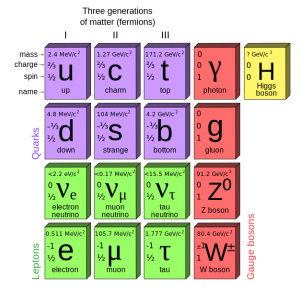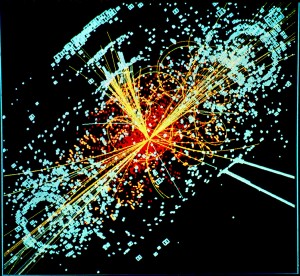On The Little Bump That Could…
I’m trying to remember exactly when I learned that the seemingly solid world around me is actually made up of uncountable smaller pieces and I cannot. I probably learned it in a real way in high-school, but I remember trying to puzzle out chemistry diagrams in my encyclopedias as a kid. The ones that look like Tinker Toys, glossy coloured balls joined by black sticks. I remember learning of a simple demonstration using agitated B.B.s to push a plunger up, and then using just air to do the same. The comparison was simple: the air too was made of smaller things. I remember learning of atoms and periodic tables and Bohr-Rutherford diagrams. Finally I remember learning of that atoms too are made of parts and those parts of even more parts. Protons, neutrons, leptons, bosons, quarks, and the other mysteries of quantum mechanics. I also learned about the Higgs boson.
Now I want to take a second here for a quick disclaimer. I am not an expert on quantum mechanics. I’m not even close. I’m just a guy who finds the nature of the universe to be fascinating and compelling. I’ve done some reading and I’m fairly interested in the subject but to be honest I don’t know a lepton from leptoff. As far as being woefully ignorant goes, I feel like I’m in good company. There is a quotation floating around that is usually attributed to Richard Feynman that goes something like “If you think that you understand quantum mechanics, then you don’t understand quantum mechanics.” The quotation seems to be either apocryphal or a reiteration of an earlier one by Neils Bohr. But the saying is apt. Quantum mechanics is weird and the more you learn about it the weirder it gets. But I digress.
 The Higgs boson is named after one Peter Higgs who was one member of a group of scientists that first proposed its existence in 1964. The Higgs boson and the Higgs field in which it propagates are thought to be what gives matter (you, me, and Bert my brass hippopotamus) its mass. The Higgs is part of what is referred to as the “standard model” of quantum mechanics. Another more colloquial way to refer to the model is “the particle zoo” and with exotic names like “strange” and “charm” and “tau” it is a strange zoo indeed. I’ve included a common diagram of the standard model so you can see what I’m talking about. The specifics aren’t really important but you can see that the chart divides the fundamental sub atomic particles of everyday matter (fermions) into two families; quarks, which make up protons and neutrons and leptons, electrons and neutrinos. Each type is also matched up with a force carrier on the right, and far to the right is the (formerly) illusive Higgs. The chart actually gets more complicated if you want to start thinking about anti-particles, but I’m not here to cause brain damage so we don’t have to go there.
The Higgs boson is named after one Peter Higgs who was one member of a group of scientists that first proposed its existence in 1964. The Higgs boson and the Higgs field in which it propagates are thought to be what gives matter (you, me, and Bert my brass hippopotamus) its mass. The Higgs is part of what is referred to as the “standard model” of quantum mechanics. Another more colloquial way to refer to the model is “the particle zoo” and with exotic names like “strange” and “charm” and “tau” it is a strange zoo indeed. I’ve included a common diagram of the standard model so you can see what I’m talking about. The specifics aren’t really important but you can see that the chart divides the fundamental sub atomic particles of everyday matter (fermions) into two families; quarks, which make up protons and neutrons and leptons, electrons and neutrinos. Each type is also matched up with a force carrier on the right, and far to the right is the (formerly) illusive Higgs. The chart actually gets more complicated if you want to start thinking about anti-particles, but I’m not here to cause brain damage so we don’t have to go there.
Developed over the course of the 20th century the standard model is basically a theory of “almost nearly everything” and is the culmination of several earlier partial theories surrounding the existence and nature of sub atomic stuff as well as the behaviours of three of the four fundamental forces. It has yet to satisfyingly connect with gravitation and relativity but I’m sure that somewhere, somebody is working on that. In its various iterations it has correctly predicted and then found several particles with the main experimental apparatus being the super nifty (read large and expensive) particle accelerators. It should be noted that most scientists will cringe, make a face, or pitch a full on fit if one refers to these as “atom smashers”. I for one always get a bit of a giggle when I think about how the smallest things known to science are being explored using the largest most complicated machines that we have ever constructed.
 For the last ten years or so the Higgs boson has been the one stubborn hold out. It is the last particle predicted to exist by the standard model that (until quite recently) has yet to be found. It all comes down to energy. In order to see smaller and smaller particles or particles existing at higher energies, we need to be able to create these higher energies. Built between 1998 and 2008 the Large Hadron Collider (LHC) near Geneva Switzerland was specifically designed to reach the energy level which the Higgs was proposed to exist. Operated by the European Organization for Nuclear Research (CERN) and employing over 10,000 scientists from over 100 countries the LHC seems to have done the job and as of March 14 2013 CERN scientists say they are very confident that they have found our wayward boson. At a recent TEDx event in Kitchener, where i live, CERN physicist Alison Lister gave a talk about particle physics and among other things touched on the discovery of the Higgs. She presented a series of data graphs layered one atop the other and pointed a a tiny bump in the data said “This bump, this is the Higgs.”
For the last ten years or so the Higgs boson has been the one stubborn hold out. It is the last particle predicted to exist by the standard model that (until quite recently) has yet to be found. It all comes down to energy. In order to see smaller and smaller particles or particles existing at higher energies, we need to be able to create these higher energies. Built between 1998 and 2008 the Large Hadron Collider (LHC) near Geneva Switzerland was specifically designed to reach the energy level which the Higgs was proposed to exist. Operated by the European Organization for Nuclear Research (CERN) and employing over 10,000 scientists from over 100 countries the LHC seems to have done the job and as of March 14 2013 CERN scientists say they are very confident that they have found our wayward boson. At a recent TEDx event in Kitchener, where i live, CERN physicist Alison Lister gave a talk about particle physics and among other things touched on the discovery of the Higgs. She presented a series of data graphs layered one atop the other and pointed a a tiny bump in the data said “This bump, this is the Higgs.”
The most interesting thing about that bump, to me, is that so far it seems to be exactly what physicists expected it to be. It fits right into the model where its supposed to and shows the attributes that it is supposed to. Scientists have spent over 40 years and billions of dollars to find this thing only to find this quiet and unassuming little particle. The Higgs boson seems to be fairly unexciting, except for the fact that is has everyone fabulously excited. I think most of the excitement surrounding the Higgs comes from two things. First, they found it! Think of it as finding the last piece to a puzzle you’ve been working on for a hundred years. The completion of this part of the standard model is a big deal. It is confirmation that we’re on the right track when it comes to figuring out what exactly the universe is all about. Secondly it also marks a beginning. As more is measured and learned about the Higgs we will learn more about how matter acquires it’s mass and perhaps more about the parts of the universe that the standard model cannot yet adequately explain. That little bump will lead to more discoveries that my kids will be able to wonder at and puzzle over as they discover science for the first time.
D.
